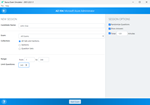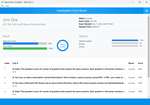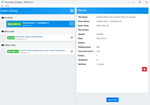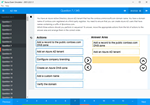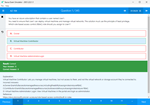Download Analyzing and Visualizing Data with Microsoft Power BI.70-778.PracticeDumps.2018-02-05.58q.tqb
| Vendor: | Microsoft |
| Exam Code: | 70-778 |
| Exam Name: | Analyzing and Visualizing Data with Microsoft Power BI |
| Date: | Feb 05, 2018 |
| File Size: | 5 MB |
How to open TQB files?
Files with TQB (Taurus Question Bank) extension can be opened by Taurus Exam Studio.
Purchase
Coupon: TAURUSSIM_20OFF
Discount: 20%
Demo Questions
Question 1
Note: This question is a part of a series of questions that present the same scenario. Each question in the series contains a unique solution that might meet the stated goals. Some question sets might have more than one correct solution, while others might not have a correct solution.
After you answer a question in this section, you will NOT be able to return to it. As a result, these questions will not appear in the review screen.
Your company has 1,000 users in a Microsoft Office 365 subscription.
A Power BI administrator named Admin1 creates 20 dashboards and shares them with 50 users.
You discover that a use name User1 can access all the dashboards.
You need to prevent User1 from accessing all the dashboards.
Solution: From the properties of each dashboard, you modify the Share settings.
Does this meet the goal?
- Yes
- No
Correct answer: B
Explanation:
References: https://docs.microsoft.com/en-us/power-bi/service-admin-administering-power-bi-in-your-organization#how-do-i-remove-power-bi-for-users-that-already-signed-up References: https://docs.microsoft.com/en-us/power-bi/service-admin-administering-power-bi-in-your-organization#how-do-i-remove-power-bi-for-users-that-already-signed-up
Question 2
Note: This question is a part of a series of questions that present the same scenario. Each question in the series contains a unique solution that might meet the stated goals. Some question sets might have more than one correct solution, while others might not have a correct solution.
After you answer a question in this section, you will NOT be able to return to it. As a result, these questions will not appear in the review screen.
Your company has 1,000 users in a Microsoft Office 365 subscription.
A Power BI administrator named Admin1 creates 20 dashboards and shares them with 50 users.
You discover that a use name User1 can access all the dashboards.
You need to prevent User1 from accessing all the dashboards.
Solution: From the Power BI Admin portal, you modify the Dashboard settings.
Does this meet the goal?
- Yes
- No
Correct answer: B
Explanation:
References: https://docs.microsoft.com/en-us/power-bi/service-admin-administering-power-bi-in-your-organization#how-do-i-remove-power-bi-for-users-that-already-signed-up References: https://docs.microsoft.com/en-us/power-bi/service-admin-administering-power-bi-in-your-organization#how-do-i-remove-power-bi-for-users-that-already-signed-up
Question 3
Note: This question is a part of a series of questions that present the same scenario. Each question in the series contains a unique solution that might meet the stated goals. Some question sets might have more than one correct solution, while others might not have a correct solution.
After you answer a question in this section, you will NOT be able to return to it. As a result, these questions will not appear in the review screen.
Your company has 1,000 users in a Microsoft Office 365 subscription.
A Power BI administrator named Admin1 creates 20 dashboards and shares them with 50 users.
You discover that a use name User1 can access all the dashboards.
You need to prevent User1 from accessing all the dashboards.
Solution: From Microsoft Azure Active Directory, you remove the Power BI license from User1.
Does this meet the goal?
- Yes
- No
Correct answer: A
Explanation:
References: https://docs.microsoft.com/en-us/power-bi/service-admin-administering-power-bi-in-your-organization#how-do-i-remove-power-bi-for-users-that-already-signed-up References: https://docs.microsoft.com/en-us/power-bi/service-admin-administering-power-bi-in-your-organization#how-do-i-remove-power-bi-for-users-that-already-signed-up
Question 4
Note: This question is a part of a series of questions that present the same scenario. Each question in the series contains a unique solution that might meet the stated goals. Some question sets might have more than one correct solution, while others might not have a correct solution.
After you answer a question in this section, you will NOT be able to return to it. As a result, these questions will not appear in the review screen.
You have a Power BI model that contains two tables named Sales and Date. Sales contains four columns named TotalCost, DueDate, ShipDate, and OrderDate. Date contains two columns named Date and Time.
The tables have the following relationships:
- Sales [DueDate] and Date [Date]
- Sales [ShipDate] and Date [Date]
- Sales [OrderDate] and Date [Date]
The active relationship is on Sales [DueDate].
You need to create measures to count the number of orders by [ShipDate] and orders by [OrderDate]. You must meet the goal without loading any additional data.
Solution: You create a calculated table. You create a measure that uses the new table.
Does this meet the goal?
- Yes
- No
Correct answer: B
Question 5
Note: This question is a part of a series of questions that present the same scenario. Each question in the series contains a unique solution that might meet the stated goals. Some question sets might have more than one correct solution, while others might not have a correct solution.
After you answer a question in this section, you will NOT be able to return to it. As a result, these questions will not appear in the review screen.
You have a Power BI model that contains two tables named Sales and Date. Sales contains four columns named TotalCost, DueDate, ShipDate, and OrderDate. Date contains two columns named Date and Time.
The tables have the following relationships:
- Sales [DueDate] and Date [Date]
- Sales [ShipDate] and Date [Date]
- Sales [OrderDate] and Date [Date]
The active relationship is on Sales [DueDate].
You need to create measures to count the number of orders by [ShipDate] and orders by [OrderDate]. You must meet the goal without loading any additional data.
Solution: You create two copies of the Date table named ShipDate and OrderDateGet. You create a measure that uses the new tables.
Does this meet the goal?
- Yes
- No
Correct answer: B
Question 6
Note: This question is a part of a series of questions that present the same scenario. Each question in the series contains a unique solution that might meet the stated goals. Some question sets might have more than one correct solution, while others might not have a correct solution.
After you answer a question in this section, you will NOT be able to return to it. As a result, these questions will not appear in the review screen.
You have a Power BI model that contains two tables named Sales and Date. Sales contains four columns named TotalCost, DueDate, ShipDate, and OrderDate. Date contains two columns named Date and Time.
The tables have the following relationships:
- Sales [DueDate] and Date [Date]
- Sales [ShipDate] and Date [Date]
- Sales [OrderDate] and Date [Date]
The active relationship is on Sales [DueDate].
You need to create measures to count the number of orders by [ShipDate] and orders by [OrderDate]. You must meet the goal without loading any additional data.
Solution: You create measures that use the CALCULATE, COUNT, and FILTER DAX functions.
Does this meet the goal?
- Yes
- No
Correct answer: A
Explanation:
References:https://msdn.microsoft.com/en-us/library/ee634966.aspxhttps://msdn.microsoft.com/en-us/library/ee634825.aspxhttps://msdn.microsoft.com/en-us/library/ee634791.aspx References:
https://msdn.microsoft.com/en-us/library/ee634966.aspx
https://msdn.microsoft.com/en-us/library/ee634825.aspx
https://msdn.microsoft.com/en-us/library/ee634791.aspx
Question 7
Note: This question is a part of a series of questions that present the same scenario. Each question in the series contains a unique solution that might meet the stated goals. Some question sets might have more than one correct solution, while others might not have a correct solution.
After you answer a question in this section, you will NOT be able to return to it. As a result, these questions will not appear in the review screen.
You have a query for a table named Sales. Sales has a column named CustomerID. The Data type of CustomerID is Whole Number.
You refresh the data and find several errors. You discover that new entries in the Sales table contain nonnumeric values.
You need to ensure that nonnumeric values in the CustomerID column are set to 0.
Solution: From Query Editor, select the CustomerID column and click Remove Errors.
Does this meet the goal?
- Yes
- No
Correct answer: B
Question 8
Note: This question is a part of a series of questions that present the same scenario. Each question in the series contains a unique solution that might meet the stated goals. Some question sets might have more than one correct solution, while others might not have a correct solution.
After you answer a question in this section, you will NOT be able to return to it. As a result, these questions will not appear in the review screen.
You have a query for a table named Sales. Sales has a column named CustomerID. The Data type of CustomerID is Whole Number.
You refresh the data and find several errors. You discover that new entries in the Sales table contain nonnumeric values.
You need to ensure that nonnumeric values in the CustomerID column are set to 0.
Solution: From Query Editor, select the CustomerID column and click Replace Values…
Does this meet the goal?
- Yes
- No
Correct answer: B
Question 9
Note: This question is a part of a series of questions that present the same scenario. Each question in the series contains a unique solution that might meet the stated goals. Some question sets might have more than one correct solution, while others might not have a correct solution.
After you answer a question in this section, you will NOT be able to return to it. As a result, these questions will not appear in the review screen.
You have a query for a table named Sales. Sales has a column named CustomerID. The Data type of CustomerID is Whole Number.
You refresh the data and find several errors. You discover that new entries in the Sales table contain nonnumeric values.
You need to ensure that nonnumeric values in the CustomerID column are set to 0.
Solution: From Query Editor, select the CustomerID column and click Replace Errors.
Does this meet the goal?
- Yes
- No
Correct answer: A
Explanation:
References: https://docs.microsoft.com/en-us/power-bi/desktop-shape-and-combine-data References: https://docs.microsoft.com/en-us/power-bi/desktop-shape-and-combine-data
Question 10
Note: This question is a part of a series of questions that present the same scenario. For your convenience, the scenario is repeated in each question. Each question presents a different goal and answer choices, but the text of the scenario is exactly the same in each question in this series.
Start of repeated scenario
You have a Microsoft SQL Server database that has the tables shown in the Database Diagram exhibit. (Click the Exhibit.)

You plan to develop a Power BI model as shown in the Power BI Model exhibit. (Click the Exhibit).

You plan to use Power BI to import data from 2013 to 2015.
Product Subcategory [Subcategory] contains NULL values.
End of repeated scenario.
You implement the Power BI model.
You need to add a new column to the Product Subcategory table that uses the following formula.
=if [Subcategory] =null then “NA” else [Subcategory]
Which command should you use in Query Editor?
- Column From Examples
- Custom Column
- Invoke Custom Function
- Conditional Column
Correct answer: D
Explanation:
References: http://community.powerbi.com/t5/Desktop/if-then-else/td-p/117999 References: http://community.powerbi.com/t5/Desktop/if-then-else/td-p/117999
HOW TO OPEN VCE FILES
Use VCE Exam Simulator to open VCE files

HOW TO OPEN VCEX FILES
Use ProfExam Simulator to open VCEX files


ProfExam at a 20% markdown
You have the opportunity to purchase ProfExam at a 20% reduced price
Get Now!